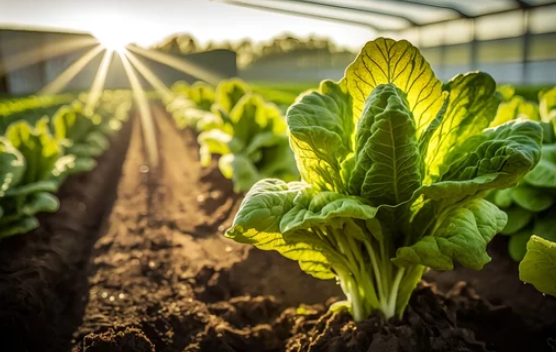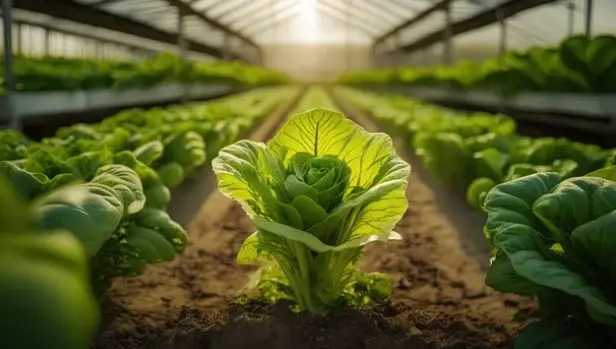Romaine lettuce is a popular vegetable that is easy to grow and has a delicious, crisp flavor.
Whether you are an experienced gardener or a beginner, growing romaine lettuce is a great way to add fresh, healthy greens to your diet.
With the right soil, water, and care, you can enjoy a bountiful harvest of this tasty lettuce variety.
To start growing romaine lettuce, it is important to choose the right location in your garden.
Romaine lettuce thrives in full sun, but it can also tolerate some shade. The soil should be well-draining and rich in organic matter.
Before planting, it is a good idea to amend the soil with compost or other organic materials to provide the nutrients that the lettuce needs to grow.
Once you have selected your planting location and prepared the soil, it’s time to plant the romaine lettuce seeds.
You can start the seeds indoors or sow them directly in the garden.
With proper watering and care, the seeds will germinate within a week or two, and you will soon have a crop of delicious, nutritious romaine lettuce to enjoy.

Choosing the Right Location
When it comes to growing romaine lettuce, choosing the right location is crucial. The location must provide adequate sunlight and soil quality to ensure the plant grows healthy and strong. Here are a few things to consider when selecting a location for your romaine lettuce.
Sunlight Requirements
Romaine lettuce requires at least six hours of direct sunlight per day. Therefore, choose a location that receives ample sunlight throughout the day. If you live in an area with hot summers, consider planting your romaine lettuce in a spot that receives partial shade during the hottest part of the day.
Soil Quality
The soil quality is also an important factor to consider when growing romaine lettuce. The soil must be well-draining, fertile, and rich in organic matter. Romaine lettuce prefers a soil pH between 6.0 and 7.0, which is slightly acidic to neutral.
Before planting, prepare the soil by adding compost or well-rotted manure to improve its fertility and texture. You can also add a balanced fertilizer to provide essential nutrients for the plant. Avoid planting romaine lettuce in soil that is compacted, waterlogged, or has poor drainage.
In summary, choosing the right location for your romaine lettuce is essential for a successful harvest. Make sure the location receives adequate sunlight and has well-draining, fertile soil. By providing the right conditions, you can grow healthy and delicious romaine lettuce in your backyard.

Growing Romaine Lettuce
Preparing the Soil
Clearing the Area
Before planting romaine lettuce, it is important to clear the area of any weeds or debris. This will ensure that the lettuce has enough space to grow and will not have to compete with other plants for nutrients. To clear the area, use a hoe or hand trowel to remove any weeds and their roots. Be sure to remove any large rocks or debris as well.
Adding Compost
Once the area has been cleared, it is time to add compost to the soil. Compost is a mixture of organic matter that has decomposed over time and is rich in nutrients that plants need to grow. It also helps to improve soil structure and water retention.
To add compost, spread a layer of it over the soil and mix it in with a garden fork or tiller. The amount of compost needed will depend on the size of the area you are planting. As a general rule of thumb, use about 2-3 inches of compost for every 6 inches of soil.
It is important to note that if the soil is already rich in nutrients, adding too much compost can actually harm the plants. Use a soil test kit to determine the nutrient levels in the soil before adding compost.
By clearing the area of weeds and debris and adding compost to the soil, you can create the ideal growing conditions for romaine lettuce. With proper soil preparation, your lettuce will have a strong foundation for healthy growth.
Planting Romaine Lettuce
Seed Selection
When selecting romaine lettuce seeds, it is important to choose a variety that is well-suited for your climate. Look for seeds that are labeled as heat-tolerant if you live in a warmer area, or cold-tolerant if you live in a cooler climate. Additionally, be sure to choose seeds that are fresh and have a high germination rate.
Spacing and Depth
Romaine lettuce should be planted in rows that are spaced 12-18 inches apart. The seeds should be planted 1/4 to 1/2 inch deep, and should be spaced approximately 6 inches apart within the row. Once the seeds have been planted, cover them lightly with soil and water gently.
Watering and Fertilizing
Romaine lettuce requires consistent moisture to grow properly. Water the plants deeply once or twice a week, depending on the weather conditions. Be sure to water the plants at the base, rather than from overhead, to prevent the leaves from becoming wet and potentially developing disease.
Fertilize the plants with a balanced fertilizer every 3-4 weeks, following the manufacturer’s instructions for application rates. Be careful not to over-fertilize, as this can lead to excessive leaf growth and poor flavor.
By following these tips for planting romaine lettuce, you can enjoy a bountiful harvest of fresh, delicious greens.
Maintaining Your Lettuce
Once your romaine lettuce is planted, it is important to maintain it properly to ensure a healthy and bountiful harvest. Here are some tips for maintaining your lettuce:
Pest and Disease Control
Pests and diseases can quickly destroy your lettuce crop, so it is important to take preventative measures to keep them at bay. Here are some ways to control pests and diseases:
-
- Keep your lettuce bed clean and free of weeds.
- Rotate your crops to prevent the buildup of pests and diseases in the soil.
- Use organic pest control methods, such as insecticidal soap or neem oil.
- Keep an eye out for signs of disease, such as yellowing or wilting leaves, and remove any affected plants immediately.
Harvesting Your Lettuce
Harvesting your lettuce at the right time is crucial to ensuring the best flavor and texture. Here are some tips for harvesting your lettuce:
- Wait until the leaves are at least 4-6 inches long before harvesting.
- Use a sharp knife or scissors to cut the leaves off at the base of the plant.
- Leave the outer leaves intact to allow for regrowth.
- Harvest in the morning when the leaves are crisp and cool.
By following these tips for maintaining your romaine lettuce, you can ensure a healthy and productive crop.
Conclusion
Growing romaine lettuce is a rewarding experience for any gardener. By following the right steps, you can enjoy a bountiful harvest of fresh, crispy greens that are perfect for salads, sandwiches, and other dishes.
One of the most important things to keep in mind when growing romaine lettuce is to choose the right location. Romaine lettuce needs plenty of sunlight and well-draining soil to thrive, so make sure you select a spot that meets these requirements.
Another key factor to consider is watering. Romaine lettuce needs consistent moisture to grow properly, but it’s important not to overwater it. Be sure to water your plants regularly, but avoid letting the soil become waterlogged.
When it comes to fertilizing, using a balanced fertilizer can help ensure that your romaine lettuce gets the nutrients it needs to grow strong and healthy. You can also consider using organic fertilizers, such as compost or manure, to provide your plants with natural sources of nutrition.
Overall, growing romaine lettuce is a fun and rewarding experience that can yield delicious results. With the right care and attention, you can enjoy a plentiful harvest of fresh greens that are perfect for any meal.




